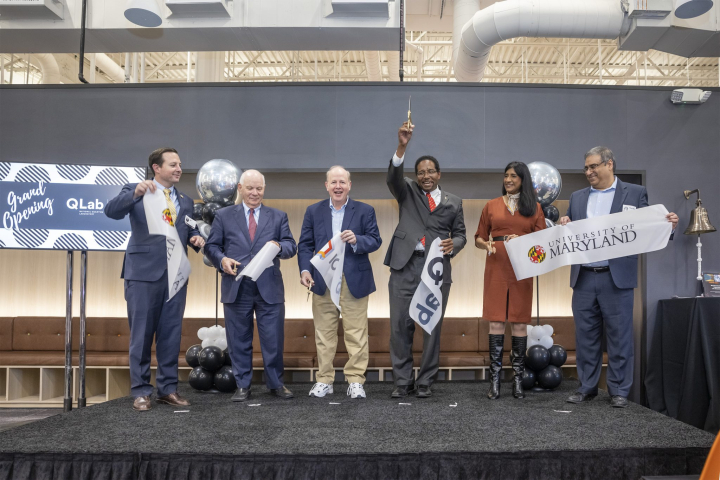UMD and IonQ celebrate National Quantum Laboratory opening
More than 100 people gathered at IonQ’s College Park headquarters Tuesday for the opening of the National Quantum Laboratory.
The National Quantum Laboratory, located just off campus, was created in partnership with the University of Maryland and quantum computing company IonQ. The research center is the nation’s first facility that allows researchers to use a commercial-grade quantum computer.
A nearly $20 million investment from this university helped furnish the research center with cutting-edge technology and workspaces, which will connect leaders in quantum computing research.
The National Quantum Laboratory will put the university at the forefront of quantum research. The rapidly-emerging technology solves problems too complicated for classic computers, according to senior computer science major Mark Levin, who worked for IonQ over the summer.
The partnership was first proposed in 2021 after IonQ went live on the New York Stock Exchange. Part of this university’s investment gives the school access to IonQ’s quantum software.
“[This lab] is the first of its kind, where the outside world can use actual quantum computers for the problems that they’re working on,” University President Darryll Pines told The Diamondback. “This is an exciting day for College Park, exciting day for IonQ, exciting day for the state of Maryland.”
U.S. Sen. Ben Cardin (D-Md.), Maryland Senate President Bill Ferguson and Maryland Lt. Gov. Aruna Miller spoke at Tuesday’s event.
Cardin said the National Quantum Laboratory will provide jobs, aid in battery development and deal with challenges in providing health care.
“Our federal delegation is on your side,” Cardin said at the event. “What you’re doing here today is critically important to America’s future, and quite frankly, the global future.”
John Sawyer, director of strategic research initiatives at this university, said one of the future aims of the National Quantum Laboratory is to use quantum computing to help solve other people’s problems. Students in this university’s First-Year Innovation & Research Experience program will be able to work with the lab, he said.
“We are really trying to build and grow the capital of quantum,” Sawyer said. “The QLab is really a cornerstone for that.”
One application of quantum computing is studying greenhouse gasses, according to Emil Żak, a physicist at quantum computing software company BEIT.
It’s difficult to measure the concentration of greenhouse gas molecules in the Earth's atmosphere without the support of quantum-mechanical calculations, he said. To answer this question, researchers can use quantum computing to perform more accurate, faster calculations and study how greenhouse gasses evolve, Żak said.
President and CEO of IonQ Peter Chapman emphasized the power of quantum computers while speaking at the event. He said one of the lab’s first projects is to develop a quantum network. This would be similar to the current internet but could potentially solve unhackable security and solving tasks in minutes that would otherwise take years.
“This is really just the beginning,” Chapman said at the event. “It’s been an amazing ride so far. But to be honest, it’s nothing compared to where we’re gonna go next.”
Story by the Diomandback
The Department welcomes comments, suggestions and corrections. Send email to editor [-at-] cs [dot] umd [dot] edu.
